Motornet: Holden Gives It Some Gas
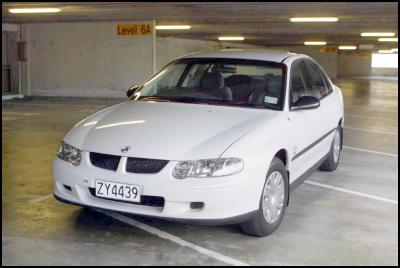
Want to save the planet and money, but not get left behind at the traffic lights? The new Holden Commodore dual -fuel could be the car for you...and if you're wearing the right uniform, you might just catch yourself some crooks.
"You must get a lot of strange looks driving a white Holden," said the cheerful Maori bloke at the carpark ticket booth. I was running late for a meeting, and looked at him rather blankly. "You know, it looks just like a cop car," he added.
Which was kind of ironic, I thought as I sped away. In white, the Holden does look a lot like a cop car, and as it happens, just a few weeks earlier, the New Zealand Police announced that it planned to purchase 400 new Holdens - over half of them white frontline vehicles - to upgrade their aging police fleet. Not that there is anything special in that, except that these cars are dual-fuel cars, or equipped with both LPG and petrol.
As was the white Holden I was driving when I got spotted by the ticket guy. Getting back from my meeting, the sharp-eyed carpark man saw me coming. He came racing out of his booth to punch the button to get me a new ticket. "That's the new dual-fuel Holden I read about in Driver magazine isn't it? I knew I recognised it," he gushed enthusiastically.
I admitted it was and thus ensued a brief but interesting conversation about the merits of dual-fuel. He admitted he was both a fan of Holdens and of LPG. If I were in marketing, that man and his car magazine would have made my day. Everybody knows that Kiwis are car crazy, but for him to have taken such an intense interest in a not hugely changed Holden product is truly remarkable. It is certainly an endorsement of the power of the brand.
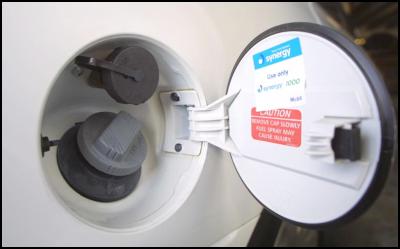
As for his building, while I admire the likes of Schumacher and other Formula One racing drivers, you haven't really achieved the pinnacle of driving until you have successfully negotiated a Wellington carpark building. They were certainly not designed with big Aussie sixes in mind and piloting an unfamiliar car around said carpark when the last thing you want is a scrape with a concrete pillar is definitely not for the faint hearted. Don't even get me started on trying to get the car into a park more suited to a Mini.
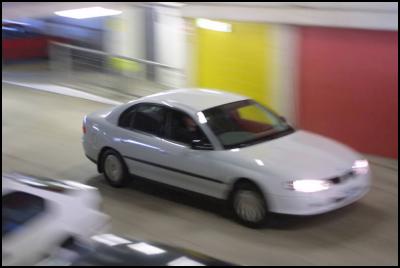
What did spring to mind, as I carefully negotiated my way down through the levels, is how much more responsive this Commodore is over some of its predecessors. You are always aware the power is going through the rear wheels, but the steering is light and responsive, and the mass of the car tends to shrink around the driver.
You would definitely need to be sharp-eyed to notice that this car was equipped with LPG or that it was a new VX Commodore rather than a VT. Externally, treatment is light. New front headlights and a cleaner grill adorn the front, while at the rear, the reflector plastic that sat between the taillights of the VT is gone leaving just painted metal - a subtle but distinctive change. Overall, the update serves to freshen the look of the car, even though the VT design was managing to age gracefully.
Unlike Ford, who offer a couple of trim levels for their LPG only Falcon, the Holden version comes in Executive trim or.... Executive trim. After being pampered by the luxury of a Volvo S60, I was expecting the worst. I needn't have worried. The Executive may not have all the creature comforts of its more expensive siblings, but it's not bad on the equipment front including dual airbags, remote central locking, manual air conditioning, and a six-speaker stereo with single in-dash CD player. You do have to crank the windows yourself though; something a lot of people dislike according to the local dealer. The seat trim of the test car was an attractive grey and the overall interior fit and finish was impressive, better again than the 'good already' VT. Front seats are genuinely comfortable and fully adjustable while the rear pews offer as generous a space as you would expect in car this size.
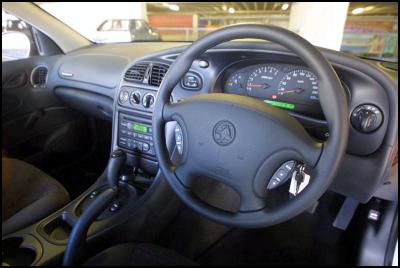
What about the cost of the LPG conversion you ask? On top of the price of a standard Executive sedan currently retailing at $41,400, you simply add $1800. Same with any of the other models offered with the conversion such as the wagon and two Holden Ute variants (the V6 auto and the 'S' variant). Yes, purchasers pay a slightly higher price tag, but recouping that initial investment won't take long - on average, most motorists will only have to travel 30,000km. With over 600 LPG outlets in the country, finding a pump to fill up with shouldn't pose a problem, and as petrol prices continue to fluctuate, 65 cents a litre for LPG is certainly attractive.
Keep in mind that you do use more LPG than petrol, but even worse case figures of 16 litres/100km would see a saving – and the average of 12 litres/100km is only marginally worse than the 10 litre average of petrol.
There are other costs of course. Most notably, is the reduced size of the boot. Taxi drivers will likely will see the cost-saving benefit outweighing the loss of boot size, but for owners with large families or reps who need a lot of space, it could prove a deciding factor at purchase time. LPG also incurs some weight gain, but not a huge amount.
Not that any of this is anywhere near as important as how the car performs. The question many will ask is 'will my Datsun now outrun an LPG cop car?' Alas (for the criminally minded), the answer is no - the car is a good performer on either fuel.
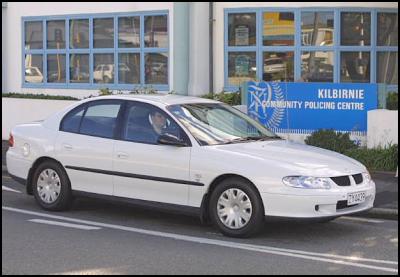
Underneath the bonnet lies the standard Commodore 3.8 litre ECOTEC V6 motor that develops 152Kw at 5200rpm. It’s a solid power plant, and while not one to provide instant acceleration, it provides good mid-range torque and adequate power to haul the standard Commodore's 1519kgs respectably, or this cars 1600kgs when you include the extra weight of the LPG conversion.
To be honest, running on LPG you would be hard pressed to know the difference between the two fuels. On very steep Wellington hills, it's possible to notice a very slight drop-off in power, but it is so slight as to be barely noticeable. To put it in perspective, a recent Wheels comparison (keep in mind Australia's higher octane fuel) recorded a 0-100 time of 10.4 seconds on petrol, versus 10.6 seconds for the LPG. Overtaking acceleration figures were similarly close. Those figures don't lie - gone are the days when gas equated with gutless.
Which is a pretty good sign for any manufacturers bringing dual-fuel vehicles to the New Zealand market. Everyone knows that cop cars have a pretty hard life and if the people behind the purchase think they can stand the test of time, they must be confident in the product. And, as the world faces up to the reality of climate change, introducing a more environmentally friendly fuel for the traditional petrol hogging Aussie has got to be a good thing. Running on LPG, the Commodore produces significantly less carbon dioxide than on petrol and considerably less air pollutants. Not to mention providing a genuine marketing advantage over competitors who don't offer LPG as an alternative...
Neither should potential purchasers forget that with the Commodore, you also have the choice of petrol (if you ever do find yourself on the back roads of the West Coast with the fuel light blinking). Changing fuels couldn't be easier. As long as you have 2000rpm on the tachometer, you simply press the large button on the transmission tunnel and you've changed - simple as that. Mostly, it's less noticeable than changing gear. The fuel gauge and trip computer update automatically as well.
While the car will always start on petrol (a relief to those who think LPG is too dry even for a modern engine), you can have it set to LPG and it will begin to run on the alternative gas accordingly.
Holden are being deliberately conservative in their estimates for sales of cars equipped with the LPG conversion. They are estimating that only one to one-and-a-half percent of all Commodore sales - nearly 5000 units in 2000 - will include LPG. For those who do a high mileage, it is likely to present a very attractive, not to mention affordable, option indeed, though admittedly, Holden may struggle to convert the private buyers market who will no doubt view LPG somewhat suspiciously.
Which is a shame. I was fortunate enough to spend about 10 days with the car, so got a good feel for the nuances associated with both fuels. Honestly, I couldn't see any reason why I wouldn't always run on gas - the difference was that minimal. Keep in mind too, that with both tanks on full (60 litres LPG and 75 litres petrol), the range of the car is as much as 800+ kilometres. All I can say is, if you're ever being pursued by an LPG cop car, you better be carrying reserve fuel tanks, because the likelihood of the cop running out of juice is very remote indeed...
Specifications
Price - $43,200
Engine - 3800cc ECOTEC V6 motor developing 152 kilowatts at 5200rpm.
Weight - 1600kg
Performance - 0-100km/ph in 10.4 seconds (petrol) and 10.6 seconds (LPG) as recorded by Australian Wheels magazine.


 Gordon Campbell: On Why The US Stands To Lose The Tariff Wars
Gordon Campbell: On Why The US Stands To Lose The Tariff Wars Eugene Doyle: Before It’s Too Late - Reimagine New Zealand’s Military Future
Eugene Doyle: Before It’s Too Late - Reimagine New Zealand’s Military Future  Binoy Kampmark: Gender Stunts In Space - Blue Origin’s Female Celebrity Envoys
Binoy Kampmark: Gender Stunts In Space - Blue Origin’s Female Celebrity Envoys Richard S. Ehrlich: A Deadly Earthquake & Chinese Construction
Richard S. Ehrlich: A Deadly Earthquake & Chinese Construction Ian Powell: It Does Matter To Patients Whether They Are Operated In A Public Or Private Hospital
Ian Powell: It Does Matter To Patients Whether They Are Operated In A Public Or Private Hospital Gordon Campbell: On Marketing The Military Threat Posed By China
Gordon Campbell: On Marketing The Military Threat Posed By China